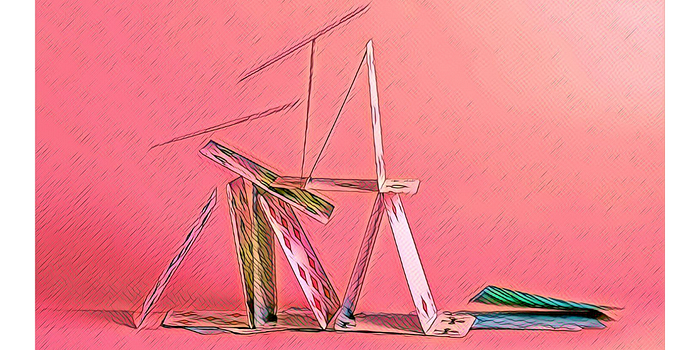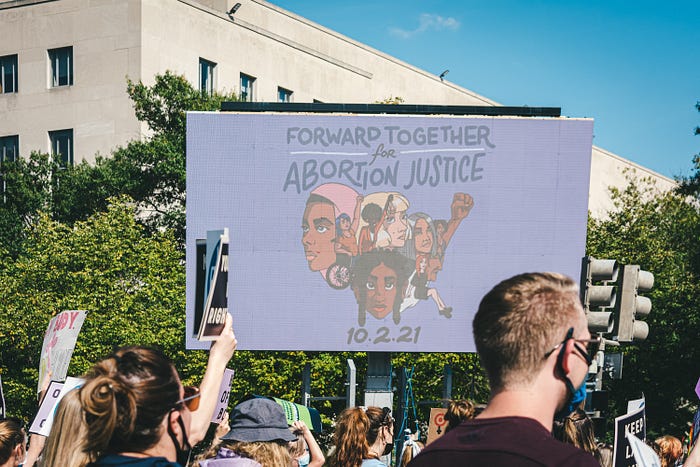How structural racism set Roe up to fall
By Jessi Corcoran
Content Warning: This blog post discusses direct impacts of the overturning of Roe v. Wade and touches on the history of sexual violence and reproductive control inflicted upon Black, Indigenous, and other people of color. To jump past this content, scroll to the header, “Reproductive justice is public health.”

When the Supreme Court overturned Roe v. Wade, the first thing I did as a pregnant woman living in Wisconsin was to google our existing state law regarding abortion. Passed in 1849, it allows abortions only for the sake of saving the “mother’s”* life, and at least two physicians must agree that the abortion is necessary. Otherwise, the abortion provider is committing a felony.
My pregnancy was planned, desired. Yet I will live in fear for the remainder of it. What if I need an abortion to save my life, but multiple physicians cannot be contacted in time, or they don’t agree about the likelihood of my death? What if I lose this child but am forced to carry them to term? Just last month, a woman in Wisconsin bled for more than 10 days when ER staff refused to remove fetal tissue after her incomplete miscarriage, putting her in severe danger.
Still, as a White, middle class, straight, cis woman, if I needed an abortion that wasn’t an emergency, I could probably access this care without discrimination or ruinous financial burden. I could manage the travel, sick days, hotel stay, and cost to receive abortion care. This is not the case for most people.
The physical, mental, emotional, and financial ramifications of the Supreme Court’s decision on our neighbors and loved ones will be staggering and swift. And the biggest impact will, as always, fall disproportionately on the most marginalized, disenfranchised communities.
White supremacy and reproductive control, past and present
While many are stunned at this rollback in reproductive rights, the truth is that the right to abortion and bodily autonomy has never been guaranteed for all. In fact, the Supreme Court’s decision is aligned with centuries-long, state-sanctioned racist oppression that has repeatedly denied the bodily autonomy of Black, Indigenous, and other people of color communities (BIPOC).
Sexual violence and reproductive control have been standard practices of the white supremacy, colonization, genocide, and race-based slavery that founded our country. When White colonizers arrived in the Americas to steal land and force European customs on Native people, they strategically perpetrated sexual violence against Indigenous people as one tactic to wipe out their people and culture. During a century of legal slave trade in the US, White people also used sexual violence, including rape, as a tool of physical and psychological control of enslaved people. In both instances, the perpetrator’s intent was often specifically reproductive control: to force the victim to bear a child.
The US government condoned and legitimized these practices, paving the way for reproductive injustice to continue today through new means.
For example, the Hyde Amendment, passed by Congress in 1977 as an amendment to the fiscal 1977 Medicaid appropriation and reimplemented every year since, bans any government dollars from being spent on abortion care. The impact? Even under Roe, Medicaid health insurance did not cover abortion services, meaning those who were least likely to be able to afford the procedure out of pocket were further denied access to it. Due to centuries of structural oppression that has purposefully blocked economic opportunity and wealth building for non-White people, Black and Brown people are more likely to be enrolled in Medicaid, making the Hyde Amendment a racially-targeted policy. These same communities are also at disproportionate risk of being uninsured and therefore lack access to basic reproductive care.
Incarcerated people, including those in ICE detention, also continue to suffer from extreme state violence and reproductive harm, pre- and post-Roe. News of the forced sterilizations in Irwin County Detention Facility sent shockwaves throughout the country in 2020, but these were, unfortunately, far from a rare occurrence.
Gabby Solano, an intimate partner violence survivor who was transferred to ICE upon her release from prison and subsequently deported to Mexico, recently shared her experience of having her ovary removed without her consent while incarcerated in Central California Women’s Facility in Chowchilla almost 20 years ago. Reparations for forced sterilization are beginning in some places, but it would be naive to believe these practices are entirely in the past.

Reproductive justice is public health
Abortion access, while essential, is only one part of the larger struggle for reproductive justice, for our collective right to live safe, healthy, happy lives.
BIPOC-led groups have been organizing for reproductive justice for decades (and longer), even with Roe v. Wade on the books. Women of Color Reproductive Justice Collective SisterSong defines reproductive justice as “the human right to maintain personal bodily autonomy, have children, not have children, and parent the children we have in safe and sustainable communities.” They emphasize that the movement is about more than abortion; it’s about access to the full spectrum of reproductive health care and improving the conditions that impact our families —conditions that public health practitioners might call the social determinants of health.
Critically, SisterSong highlights that achieving reproductive justice requires “center[ing] the most marginalized.” The right to an abortion is meaningless if it is not accessible by all, and access to abortion is undermined when other conditions continue to threaten the health and safety of families.
Because Roe did not protect all people, it was fragile. Its repeal was made possible by the precedent set by centuries of state-sanctioned racist oppression. This Supreme Court decision is only the most recent example of how structural racism poisons health and liberation. It is critical that our movements for change — be they in our communities or inside our health departments — are grounded in racial justice and equity.
As Audre Lorde said, “I am not free while any woman is unfree, even when her shackles are very different from my own.” Our health and liberation is bound together. The only way we will secure reproductive justice is by securing it for all of us.
I am not free while any woman is unfree, even when her shackles are very different from my own.
— Audre Lorde
Why abortion access and reproductive justice matters to public health
To translate all of this into public health language, the overturn of Roe:
- Is catastrophic for the health and safety of all people who can become pregnant — even deadly
- Will deepen health inequities along race, class, and gender lines
- Is one more example of how codified racism ultimately harms everyone’s health
- Will have ripple effects on all the social determinants of health and all health outcomes. Your ability to determine your reproductive future impacts and is impacted by your income, housing, education, food security, experience of incarceration, and more.

What public health can do
An attack on abortion access is an attack on the health and wellbeing of our collective communities. It’s critical that the field of public health take an unequivocal stance in support of universal access to the full spectrum of reproductive health care.
1. Take a public stance as a health department or public health professional
The field has a responsibility to advocate for health and address health inequities. Don’t fall for those who will say you are taking a political side; you are taking the side of the public’s health. Draw connections between abortion access, health and racial inequities, and the social determinants of health. Check out these examples:
- APHA News Release: Supreme Court’s Overturning of Roe v. Wade Jeopardizes the Health of All Americans
- Op Ed by Dr. Mary T. Bassett: Without My Abortion, I Would Not Be New York’s Health Commissioner
- LA Department of Public Health Press Release: Statement on Supreme Court Ruling Overturning Roe v. Wade
2. Deepen your agency’s understanding of abortion as a public health and racial justice issue
As detailed above, access to reproductive health care is not only a maternal and child health issue.
- Follow and learn from BIPOC-led organizations like SisterSong, Black Feminist Future, and Liberate Abortion
- Learn more about how abortion criminalization is part of a larger struggle against policing, racism, and criminalization: Decriminalizing Abortion: How Our Movements Can Organize in Solidarity With Each Other
- Check out NYC Department of Health’s Sexual and Reproductive Justice Framework
3. Develop and disseminate educational materials on how individuals can access abortion care
Include information about the laws and services in your state and region, abortion funds, and self-managed abortions.
4. Partner with and mobilize alongside community power building organizations (CPBOs)
CPBOs build power in communities that are most impacted by inequities. Partnerships between public health and CPBOs can be leveraged to support legislation and ballot measures that protect reproductive freedom, oppose measures that restrict access, and elect leaders with a reproductive justice agenda. For agencies constrained by politics, these partnerships create a network of allies who can apply pressure from the outside to achieve equity and justice goals.
- Begin building and deepening relationships with CPBO partners using a new guide from HIP: Resources for Collaboration and Power Sharing Between Government Agencies and Community Power-Building Organizations
- For more ideas about the role public health plays in protecting abortion access, see this blog post and its many linked resources (written before the ruling became official): What Should Public Health and Health Department Professionals Do in Preparation for Roe V. Wade Falling?
What individuals can do:
In addition to some of the actions above, you can also:
- Sign this petition from The Color of Change to tell your District Attorney that abortion is healthcare
- Donate to local and national abortion funds that help people access care, like the National Network of Abortion Funds
- Volunteer with local organizations to support people who are trying to access abortions
- Continue to show up in the streets if you are able. This map is continually updated with rallies, marches, gatherings, and actions across the country
- Check out this video series from Abortion Access Front to help you find your role in the abortion movement
- Join Public Health Awakened, Human Impact Partners’ national network of public health practitioners organizing for health, equity, and justice, to continue to take action on these issues and more
*The language in many abortion laws and the conversation surrounding Roe has often excluded transgender and gender non-conforming people. Removal of access to abortion care also impacts people who do not identify with terms like “woman” or “mother.” Note that it is best practice to use “pregnant person” and “person who can become pregnant” when discussing reproductive justice.
Jessi Corcoran is a Senior Program Associate at Human Impact Partners, where she provides training and technical assistance and develops resources to support the centering of health equity. Her roots in sexual violence prevention and activism give her a unique perspective and passion for fully integrating public health and social justice movements. Jessi is particularly interested in living and supporting the White anti-racist journey.
📌 Did you know? Human Impact Partners provides health equity capacity building to public health organizations. Contact us to learn more about our offerings at info[at]humanimpact.org.
